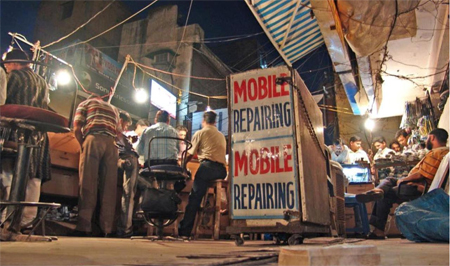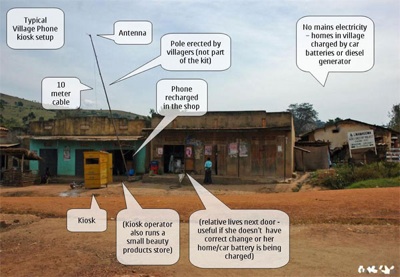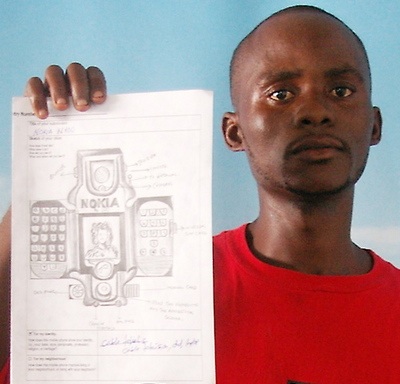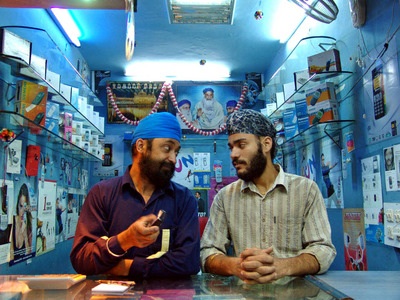The Cell Phone Platform
I am envious of Jan Chipchase. He gets paid corporate wages to hopscotch from one remote exotic destination to the next, taking pictures of local lifestyle details and interviewing local residents about their technology use. He is usually described as a ‘”user anthropologist” or a “usability ethnographer” — either one would be a cool job. I often crib fantastic images of street use examples from Jan’s site Future Perfect. Jan has always been very generous and will openly share not only his images but his annotations.
He was recently featured in a long New York Times Magazine profile that asked the larger question of whether cell phones could help cure poverty. They will certainly be part of the solution. But as this fine article points out, they are also becoming something more. The story has a lot of good news so I’ve sampled from it liberally.

Cell phone repair alley in Delhi, India
Last year, the World Resources Institute, a Washington-based environmental research group, published a report with the International Finance Corporation entitled “The Next Four Billion,” an economic study that looked at, among other things, how poor people living in developing countries spent their money. One of the most remarkable findings was that even very poor families invested a significant amount of money in the I.C.T. category — information-communication technology, which, according to Al Hammond, the study’s principal author, can include money spent on computers or land-line phones, but in this segment of the population that’s almost never the case. What they’re buying, he says, are cellphones and airtime, usually in the form of prepaid cards. Even more telling is the finding that as a family’s income grows — from $1 per day to $4, for example — their spending on I.C.T. increases faster than spending in any other category, including health, education and housing. “It’s really quite striking,” Hammond says. “What people are voting for with their pocketbooks, as soon as they have more money and even before their basic needs are met, is telecommunications.”

Chipchase annotates his photo of a Village Phone set up in Uganda.
Having a call-back number, Chipchase likes to say, is having a fixed identity point, which, inside of populations that are constantly on the move — displaced by war, floods, drought or faltering economies — can be immensely valuable both as a means of keeping in touch with home communities and as a business tool. Over several years, his research team has spoken to rickshaw drivers, prostitutes, shopkeepers, day laborers and farmers, and all of them say more or less the same thing: their income gets a big boost when they have access to a cellphone.During a 2006 field study in Uganda, Chipchase and his colleagues stumbled upon an innovative use of the shared village phone, a practice called sente. Ugandans are using prepaid airtime as a way of transferring money from place to place, something that’s especially important to those who do not use banks. Someone working in Kampala, for instance, who wishes to send the equivalent of $5 back to his mother in a village will buy a $5 prepaid airtime card, but rather than entering the code into his own phone, he will call the village phone operator (“phone ladies” often run their businesses from small kiosks) and read the code to her. She then uses the airtime for her phone and completes the transaction by giving the man’s mother the money, minus a small commission. “It’s a rather ingenious practice,” Chipchase says, “an example of grass-roots innovation, in which people create new uses for technology based on need.”

Chipchase invited local residents in Ghana to design their ideal cell phone.
As a joke, Chipchase sometimes pulls out his cellphone and pretends to shave his face with it, using a buzzing ring tone for comic effect. But there’s a deeper truth embedded here, not just for people in places like Kenya or Buduburam but for all of us. As cellphone technology grows increasingly sophisticated, it has cannibalized — for better or worse — the technologies that have come before it. Carrying a full-featured cellphone lessens your needs for other things, including a watch, an alarm clock, a camera, video camera, home stereo, television, computer or, for that matter, a newspaper. With the advent of mobile banking, cellphones have begun to replace wallets as well. That a phone might someday offer a nice close shave suddenly seems not so ridiculous after all.

What interests me most about cell phones is how fast they are displacing PCs as the center of mediated life. And how unpredicted this overthrow was when cell phones first appeared. No one forecasted these brick-sized appliances replacing personal computers, even when one could see they would get smaller. In Star Trek, where they had cell-phone like communicators, they still had mainframe terminals on the bridge.


